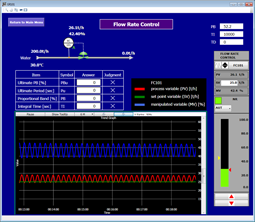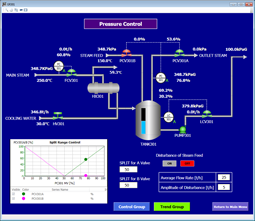- HOME
- Solution
- OmegaLand Educator
- Process Control Simulator

OmegaLand Educator Process Control Simulator
Users can learn principles and rules of process engineering efficiently.Aim of Process Control Simulator
The purpose of this simulator is to learn about the basics of process control which targets equipment generally present in chemical, petrochemical, and petroleum refining processes. For the following types of process control, users will learn about appropriate control parameter setting methods and methods for improving control performance.
- Flow rate control: ultimate sensitivity method tuning by Ziegler-Nichols, and particularities of flow rate control.
- Liquid level control: level control by outflow (PI control and the characteristics of liquid level control), cascade control with flow rate.
- Pressure control: pressure control by outflow, and split control method.
- Temperature control: PID parameter tuning by transient response method and characteristics of temperature control.
- Feed forward control: feed forward parameter determination method.
Target Process
For each type of control, a separate process is used.
In the flow rate control process, water flows in piping connected to a control valve. In the liquid level control process, water is fed into a tank that is open to the atmosphere, and the liquid level is controlled by the outflow from the tank. In the pressure control process, steam is fed to a flash tank, cooled with cooling water, the vapor and liquid are separated, and the uncondensed water vapor is discharged from the pressure control valve. In the temperature control process, hot water and cooling water flow to a heat exchanger and the outlet temperature is controlled. Lastly, in the feedforward control process, hot water and cooling water are both fed into a tank. The flow rate of the cooling water is a feed-forward element, and the temperature of the tank is controlled with the hot water flow rate.
Exercise Contents
- Flow rate control: cause the critical oscillation to the flow rate controller and find the ultimate proportional band and the ultimate period to calculate the integral time TI and proportional band PB by the Ziegler-Nichols utimate sensitivity method. Change the parameters to examine how the controllability changes.
- Liquid level control: change the proportional band PB and integral time TI, to make sure that the liquid level will remain controllable with disturbances. In addition, for a single liquid level control, examine the effect of the cascade control combining flow control and liquid level control.
- Pressure control: change the PB and TI to understand the characteristics of pressure control. Experience operating the split control system used for pressure control.
- Temperature control: obtain the equivalent dead time and the equivalent time constant using the transient response method to estimate the parameters of the PI control and PID control in the Ziegler-Nichols method. Change PB, TI, and the derivative time TD, to compare PI control and PID control and to understand the characteristics of temperature control.
- Feed forward control: find the feed-forward gain of temperature control and the liquid level control. Compare and examine the effects of control with and without a feed-forward element.
- HOME
- Solution
- OmegaLand Educator
- Process Control Simulator
Copyright © Omega Simulation Co., LTD. All Rights Reserved.



